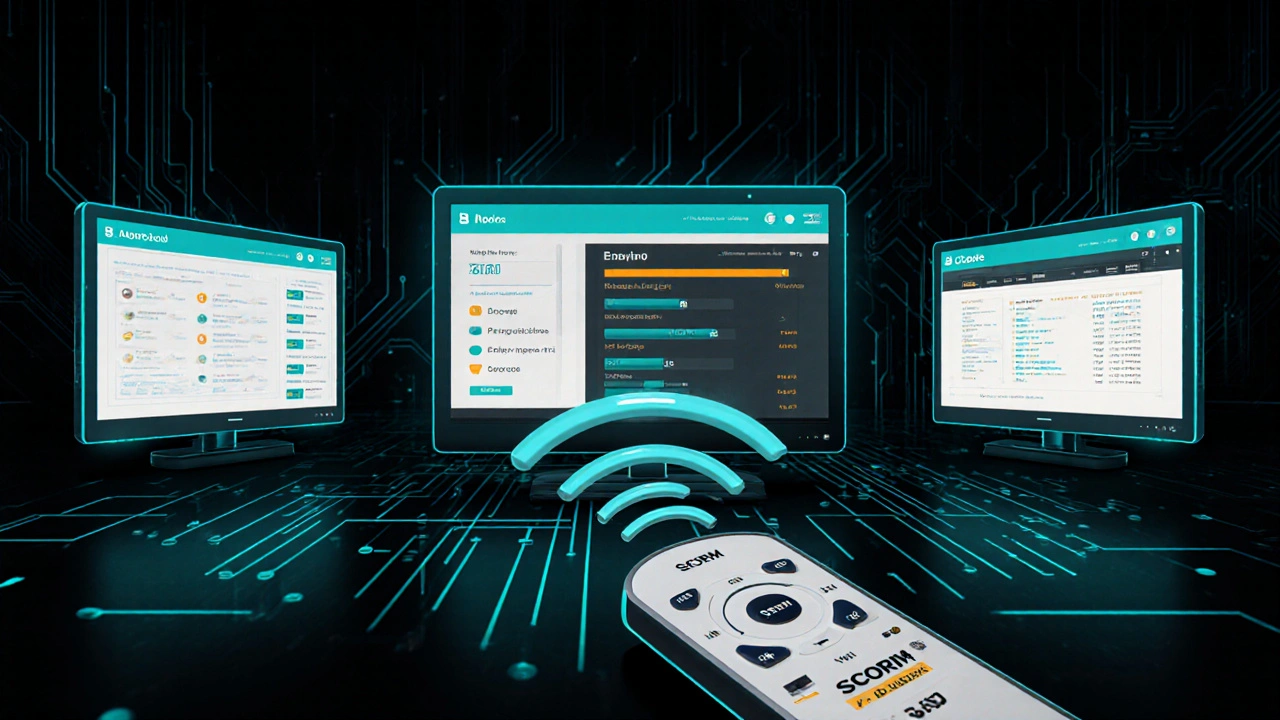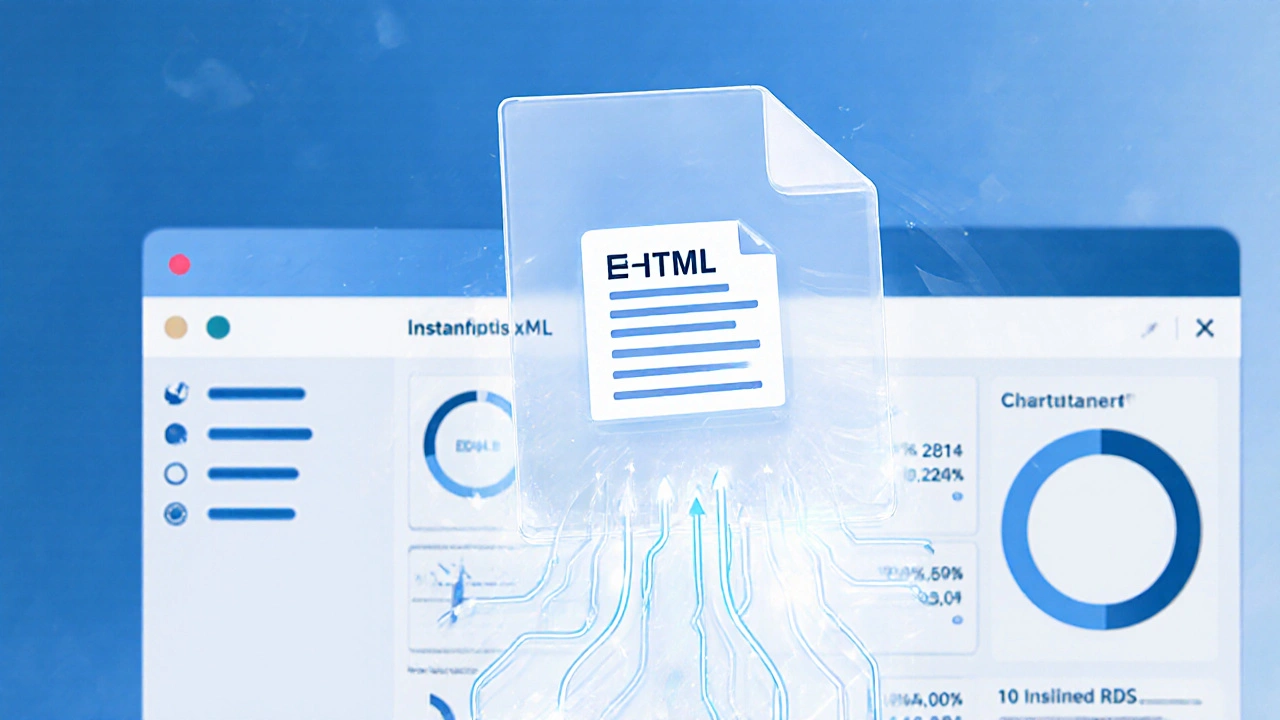If your eLearning team is struggling to get courses to work properly across different learning platforms, you’re not alone. The problem isn’t your content-it’s likely that you’re missing the glue that holds it all together: SCORM. SCORM isn’t a fancy tool or a new app. It’s a set of rules that lets your course content talk to your Learning Management System (LMS). Without it, your videos might not track progress, your quizzes won’t save scores, and your learners might end up starting over every time they log in.
What SCORM Actually Does
SCORM stands for Shareable Content Object Reference Model. That’s a mouthful, but here’s the simple version: SCORM is a technical standard that tells your eLearning content how to behave inside an LMS. Think of it like a universal remote. Your LMS is the TV, and your course is the DVD. Without SCORM, every DVD needs its own remote. With SCORM, one remote works for all.
SCORM defines how your course files (HTML, JavaScript, images, videos) should be packaged and how they should send data back to the LMS-like when a learner completes a module, what score they got, or how long they spent on a page. It’s the reason your course can be built in Articulate Storyline, uploaded to Moodle, and then moved to Cornerstone without breaking.
Before SCORM, every LMS used its own format. If you made a course for one system, it wouldn’t work on another. That meant schools and companies had to rebuild their entire training library every time they switched platforms. SCORM changed that. It gave eLearning teams a single, predictable way to build and move content.
SCORM 1.2 vs. SCORM 2004: Which One Should You Use?
There are two main versions of SCORM you’ll run into: SCORM 1.2 and SCORM 2004. Most teams still use 1.2. Why? Because it’s simple, reliable, and supported everywhere.
SCORM 1.2 is the workhorse. It tracks basic data: completion status, pass/fail, and score. If your course is a 10-minute compliance module with a 5-question quiz at the end, SCORM 1.2 does everything you need. It’s lightweight. It loads fast. And nearly every LMS made in the last 15 years can handle it without a hitch.
SCORM 2004, on the other hand, is more powerful-but also more complicated. It adds sequencing and navigation rules. That means you can build courses where learners must pass one module before moving to the next, or where they can jump back to earlier sections based on quiz results. It also supports detailed data tracking, like how many times someone clicked a button or how long they hovered over a hint.
But here’s the catch: not all LMS platforms support SCORM 2004 fully. Some only support the basics. Others crash if you use advanced sequencing. If you’re building a simple training course, SCORM 2004 is overkill. If you’re designing a complex adaptive learning path with branching scenarios, then it’s worth the extra setup.
Most eLearning teams stick with SCORM 1.2 unless they have a specific need for sequencing. Even big organizations like the U.S. Department of Defense, which helped create SCORM, still use 1.2 for the majority of their courses.

How SCORM Works Behind the Scenes
SCORM doesn’t run on its own. It’s built into your course files. When you export a course from Rise, Captivate, or any other authoring tool, it creates a folder with a bunch of files: HTML pages, JavaScript, images, and a special file called imsmanifest.xml. This file is the heart of SCORM. It tells the LMS what’s inside the course, what order to load it in, and how to communicate with it.
When a learner opens the course, the LMS loads the HTML file. That file runs JavaScript code that connects to the LMS through something called the SCORM API. This API is like a phone line between your course and the LMS. Every time the learner clicks next, answers a question, or finishes a section, the course sends a signal through that line: "User completed module 3. Score: 85%. Status: Passed."
The LMS hears that, writes it to the learner’s record, and stores it for reporting. Later, a manager can log in and see who completed the training, who failed, and how long it took. That’s all thanks to SCORM.
Without this API connection, your course is just a webpage. It looks fine, but the LMS has no idea what the learner did. No tracking. No reports. No compliance proof.
Common SCORM Problems and How to Fix Them
Even with SCORM, things go wrong. Here are the most common issues teams run into-and how to solve them.
- "My course won’t launch." Check the file structure. SCORM packages must be zipped correctly. Don’t zip the folder-zip the contents inside the folder. The
imsmanifest.xmlfile must be at the root level of the ZIP file. - "Scores aren’t saving." Make sure your authoring tool is set to send the
cmi.core.score.rawvalue. Some tools default to sending only "completed" without a score. Double-check your export settings. - "Progress resets when learners close the browser." SCORM 1.2 doesn’t automatically save progress unless the course calls the
Commit()function regularly. Most modern tools handle this, but if you’re using custom code, make sure you’re callingAPI.Commit()every few minutes or after each page change. - "It works in Chrome but not Safari." SCORM relies on JavaScript and cookies. Safari’s Intelligent Tracking Prevention can block the SCORM API. Test in different browsers. Use HTTPS. And avoid third-party iframes if possible.
One pro tip: Always test your SCORM package before uploading it to your main LMS. Use a free tool like SCORM Cloud (now part of Rustici Software) to upload and debug your package. It will show you exactly what data your course is sending-and what it’s missing.

Is SCORM Still Relevant in 2025?
You might hear people say SCORM is outdated. That’s partly true. Newer standards like xAPI (Experience API) and cmi5 can track learning across apps, mobile devices, simulations, and even real-world activities. They’re more flexible. They can track things like "learner watched a YouTube video about safety procedures" or "employee used a VR headset to practice equipment handling."
But here’s the reality: 90% of corporate and educational LMS platforms still rely on SCORM as their primary delivery method. Why? Because it works. It’s stable. It’s cheap. And switching to xAPI means rebuilding your entire course library, retraining your team, and dealing with compatibility issues across platforms.
SCORM isn’t going away anytime soon. It’s the foundation. Even if you plan to move to xAPI later, you still need to understand SCORM to manage your existing content and ensure smooth transitions.
Think of it like email. We have Slack, Teams, and WhatsApp now. But email is still the standard for formal communication. SCORM is the email of eLearning.
What to Do Next: A Quick Action Plan
If you’re on an eLearning team and you’re not sure where you stand with SCORM, here’s what to do this week:
- Check your current courses. Are they SCORM 1.2 or SCORM 2004? Open the ZIP file and look for
imsmanifest.xml. Open it in a text editor. Look for the attributeadlcp:scormversion. If it says "SCORM1.2", you’re on the older version. - Test one course in your LMS. Log in as a learner. Complete the course. Check the learner report. Did the score and completion status update? If not, your export settings are wrong.
- Talk to your LMS vendor. Ask: "Do you fully support SCORM 2004 4th Edition?" If they say "yes," but can’t show you an example of sequencing in action, they’re probably just saying yes to be safe.
- Start using SCORM Cloud to test new courses before uploading them to your main system. It saves hours of troubleshooting.
- Document your SCORM standards. Create a simple guide for your team: "All new courses must be exported as SCORM 1.2 unless otherwise approved for advanced sequencing."
SCORM isn’t glamorous. But it’s the reason your training programs work at all. Master it, and you stop fighting your technology. You start building better learning experiences.
Is SCORM required for all eLearning courses?
No, SCORM isn’t required, but if you want your course to work in most LMS platforms without custom coding, you need it. Alternatives like xAPI or HTML5-only courses exist, but they require more technical support and aren’t universally compatible. For most teams, SCORM is the lowest-risk path to reliable delivery.
Can I use SCORM with Moodle, Canvas, or Blackboard?
Yes. All three support SCORM 1.2 and SCORM 2004. Moodle has the strongest SCORM support among the three, especially for advanced features. Canvas handles SCORM well but sometimes struggles with complex sequencing. Blackboard is reliable but slower to update. Always test your package in your specific LMS before rolling out to learners.
Does SCORM work on mobile devices?
It can, but not always smoothly. Older SCORM packages built with Flash or heavy JavaScript may break on mobile. Modern SCORM courses built with responsive HTML5 work fine on iOS and Android, as long as they’re tested. Always test on actual devices-not just emulators. Some LMS apps have limited SCORM support, so check with your vendor.
What’s the difference between SCORM and xAPI?
SCORM only tracks learning that happens inside the LMS. xAPI can track learning anywhere-on a phone, in a simulation, during a meeting. xAPI uses statements like "John completed the safety drill" or "Sarah watched the onboarding video on her tablet." It’s more powerful, but also more complex. SCORM is simpler and works everywhere. Most teams use SCORM today and plan to adopt xAPI later.
Do I need to pay for SCORM?
No. SCORM is a free public standard. You don’t pay licensing fees to use it. However, authoring tools like Articulate 360 or Adobe Captivate charge for their software, and they include SCORM export as a feature. You’re paying for the tool, not the standard. Free tools like H5P also export SCORM without cost.
If your team is still manually uploading courses and guessing whether they worked, you’re wasting time. SCORM fixes that. Learn it, test it, and build with it. Your learners-and your reports-will thank you.

